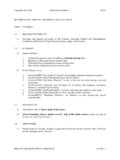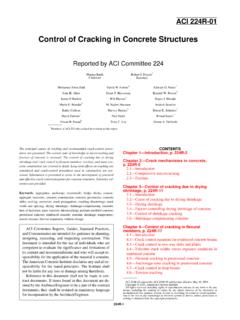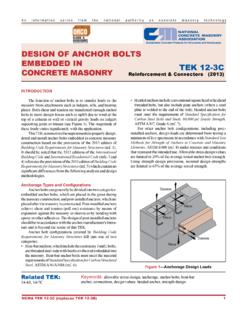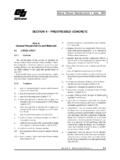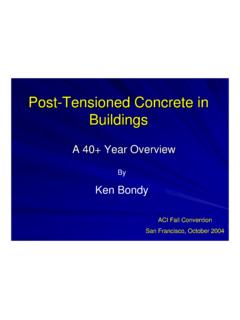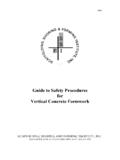Transcription of PRESTRESSED CONCRETE ANALYSIS AND DESIGN: …
1 PRESTRESSED CONCRETE ANALYSIS AND design : FUNDAMENTALS Third Edition, 2012 by Antoine E. Naaman, Fellow ACI; Fellow ASCE; Fellow PCI; Fellow IFS Professor Emeritus of Civil Engineering, University of Michigan, Ann Arbor Hardcover; 1176 pages; in. ISBN: 978-0-9674939-2-3; LCCN: 2011941025 Copyright 2012 US$ This book was written to serve as a thorough teaching text, a comprehensive source of information, and a basic reference. It is intended for advanced students, professional engineers, and researchers.
2 It emphasizes the fundamental concepts of ANALYSIS and design of PRESTRESSED CONCRETE structures, providing the user with the essential knowledge and tools to deal with everyday design problems, while encouraging the necessary critical thinking to tackle more complex problems with confidence. PRESTRESSED CONCRETE is one of the most reliable, durable, and widely used construction materials in building and bridge projects around the world. It has made significant contributions to the construction industry, the precast manufacturing industry, and the cement industry as a whole.
3 It has led to an enormous array of structural applications, including buildings, bridges, nuclear power vessels, TV towers, and offshore drilling platforms. Main Features: This updated edition Integrates the provisions of the 2011 ACI Building Code in text and examples Offers an extensive treatment of bridge ANALYSIS and design according to the 2010 AASHTO LRFD Specifications Offers a rigorous treatment of fundamentals as applied to serviceability and ultimate strength limit states for bending, shear, composite action, compression and tension members.
4 And introduces some simple optimum design approaches Includes a large number of logical design flow charts and design examples Covers the basics and provides examples of applications comparing both the 2011 ACI and 2010 AASHTO LRFD code approaches to bending, shear and torsion, prestress losses, and interface shear Presents a chapter on strut-and-tie modeling according to the ACI Building Code with examples of anchorage zone design Covers slenderness effects in PRESTRESSED CONCRETE columns, and provides load-moment interaction diagrams for PRESTRESSED columns and poles Offers a comprehensive treatment of the design of one- and two-way PRESTRESSED slabs Presents a unique treatment of PRESTRESSED tensile members by optimum design .
5 Including the design of wall for circular tanks Covers the time-step procedure to compute prestress losses and long-term deflections Offers a rigorous treatment of PRESTRESSED continuous beams Presents a comprehensive treatment of PRESTRESSED composite beams Contains more than four hundreds illustrations and photographs Covers sufficient material for a two-semester course on the subject Contains a large number of examples, an extensive updated bibliography, and an appendix with answers to study problems Uses consistent notation and consistent sign convention Uses dual units (US and SI) throughout for key equations and reference data Chapter 1 Principle and Methods of Prestressing Chapter 2 Prestressing Materials: Steel and CONCRETE Chapter 3 The Philosophy of design Chapter 4 Flexure: Working Stress ANALYSIS and design Chapter 5 Flexure.
6 Ultimate Strength ANALYSIS and design Chapter 6 design for Shear and Torsion Chapter 7 Deflection Computation and Control Chapter 8 Computation of Prestress Losses Chapter 9 ANALYSIS and design of Composite Beams Chapter 10 Continuous Beams and Indeterminate Structures Chapter 11 PRESTRESSED CONCRETE Slabs Chapter 12 ANALYSIS and design of Tensile Members Chapter 13 ANALYSIS and design of Compression Members Chapter 14 PRESTRESSED CONCRETE Bridges Chapter 15 Strut-and-Tie Modeling Appendix A List of Symbols Appendix B Unit Conversions Appendix C Typical Post-Tensioning Systems Appendix D Answers to Selected Problems Appendix E Typical Precast / PRESTRESSED Beams Index CONTENTS.
7 Preface xxiii Acknowledgments xxix Chapter 1 Principle and Methods of Prestressing 1 Introduction 1 Examples of Prestressing 2 History of PRESTRESSED CONCRETE 4 Prestressing Methods 12 Pretensioning 12 Posttensioning 17 Self-Stressing 22 Prestressing Systems 24 Particular Prestressing Techniques 25 External Prestressing 25 Circular Prestressing 27 Stage Stressing 28 Partial Prestressing 28 PRESTRESSED Versus Reinforced CONCRETE 29 Example 32 Looking Ahead 37 Suggested Additional Reading 38 References 38 Problems 42 Chapter 2 Prestressing Materials.
8 Steel and CONCRETE 45 Reinforcing Steels 45 Prestressing Steels 49 Types of Prestressing Tendons 50 Production Process 53 Mechanical and Stress-Strain Properties 55 Relaxation 58 Effects of Temperature 62 Fatigue 64 Corrosion 68 CONCRETE 70 Composition 70 Stress-Strain Curve 71 Mechanical Properties 74 Shrinkage 78 Creep 81 Fatigue 85 Effects of Temperature 85 Steam Curing 86 Constitutive Modeling 87 Stress-Strain Curve of CONCRETE in Compression 87 Stress-Strain Curve of Reinforcing Steel in Tension 90 Stress-Strain Curve of Prestressing Steels in Tension 93 Concluding Remarks 96 References 96 Problems 99 Chapter 3 The Philosophy of design 103 What is design ?
9 103 ANALYSIS or Investigation Versus design 104 design Objectives 104 Limit State design Philosophy 105 Common design Approaches 107 WSD (or ASD) 109 USD, SD, or LRFD 110 Plastic design , Limit design , and Performance Based Plastic design 113 Nonlinear design , Probabilistic design 113 design Codes 113 Loads 114 Allowable Stresses 117 CONCRETE 117 Prestressing Steel 121 Reinforcing Steel 122 Load and Strength Reduction (or Resistance) Factors 123 Load Factors 123 Strength Reduction or Resistance Factors 125 ACI Code Viewpoint Related to PRESTRESSED and Partially PRESTRESSED CONCRETE 126 Class Definition and Related Serviceability design Requirements 126 Tension Controlled and Compression Controlled Sections 128 Some design Comparisons.
10 Reinforced Versus PRESTRESSED CONCRETE 130 Practical design Approach 130 C-Force and C-Line 131 Characteristic Response of RC, PC, and PPC in Bending in the Elastic Range of Behavior 132 Curvature Computation 134 Load Balancing Feature of Prestressing 136 Detailing of Reinforcement 137 Prestress Losses in Preliminary design 140 Concluding Remarks 142 References 142 Chapter 4 Flexure: Working Stress ANALYSIS and design 145 ANALYSIS Versus design 145 Concepts of Prestressing 150 Notations for Flexure 152 Example: Computation of Sectional Properties 155 Sign Convention 155 Examples 158 Loading Stages 160 Allowable Stresses 161 Mathematical Basis for Flexural ANALYSIS 163 Geometric Interpretation of the Stress Inequality Conditions 167 Example.

